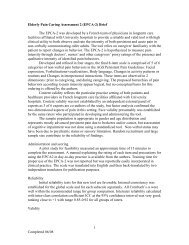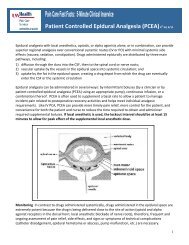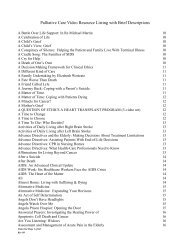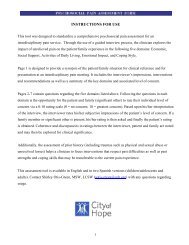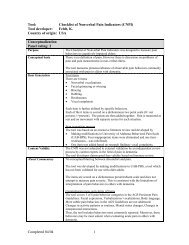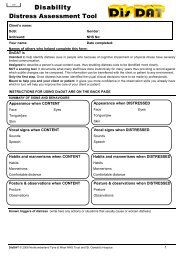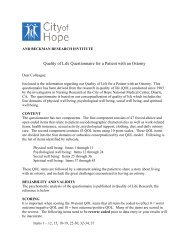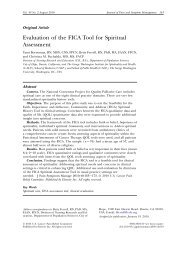Pain Assessment in Advanced Dementia - Pain Resource Center
Pain Assessment in Advanced Dementia - Pain Resource Center
Pain Assessment in Advanced Dementia - Pain Resource Center
Create successful ePaper yourself
Turn your PDF publications into a flip-book with our unique Google optimized e-Paper software.
Source of evidenceWarden, V., Hurley, A.C., Volicer, L. (2003). Development and psychometric evaluation of the <strong>Pa<strong>in</strong></strong><strong>Assessment</strong> <strong>in</strong> <strong>Advanced</strong> <strong>Dementia</strong> (PAINAD) Scale. Journal of the American Medical Directors,Jan/Feb, 9-15.Lane, P., Kuntupis, M., MacDonald, S., McCarthy, P., Panke, J., Warden, V., Volicer, L. (2003). A pa<strong>in</strong>assessment tool for people with advanced Alzheimer’s and other progressive dementias. HomeHealthcare Nurse, 21(1), 32-37.DeWaters, T., Faut-Callahan, M., McCann, J. J., Paice, J. A., Fogg, L., Holl<strong>in</strong>ger-Smith, L., et al. (2008).Comparison of self-reported pa<strong>in</strong> and the PAINAD scale <strong>in</strong> hospitalized cognitively impaired and<strong>in</strong>tact older adults after hip fracture surgery. Orthopaedic Nurs<strong>in</strong>g / National Association ofOrthopaedic Nurses, 27(1), 21-28.Costardi, D., Rozz<strong>in</strong>i, L., Costanzi, C., Ghianda, D., Franzoni, S., Padovani, A. & Trabucchi, M. (2006).The Italian version of the pa<strong>in</strong> assessment <strong>in</strong> advanced dementia (PAINAD) scale. Archives ofGerontology and Geriatrics, 44(2), 175-180.Hutchison, R., Tucker, W., Kim, S. & Gilder, R. (2006). Evaluation of a behavioral assessment tool for the<strong>in</strong>dividual unable to self-report pa<strong>in</strong>. American Journal of Hospice and Palliative Medic<strong>in</strong>e, 23(4),328-331.Leong, I., Chong, M. & Gibson, S. (2006). The use of a self-reported pa<strong>in</strong> measure, a nurse-reported pa<strong>in</strong>measure and the PAINAD <strong>in</strong> nurs<strong>in</strong>g home residents with moderate and severe dementia: a validationstudy. Age and Age<strong>in</strong>g, 35, 252-256.Schuler, M., Becker, S., Kaspar, R., Nikolaus, T., Kruse, A. & Basler, H. (2007). Psychometric propertiesof the German “<strong>Pa<strong>in</strong></strong> Assesssment <strong>in</strong> <strong>Advanced</strong> <strong>Dementia</strong>” (PAINAD-G) <strong>in</strong> Nurs<strong>in</strong>g Home residents.American Medical Directors Association, July, 388-395.Van Iersel, T., Timmerman, D. & Mullie, A. (2006). Introduction of a pa<strong>in</strong> scale for palliative care patientswith cognitive impairment. International Study of Palliative Nurs<strong>in</strong>g, 12(2), 54-59.Zwakhalen, S., Hamers, I. & Berger, M. (2006). The psychometric quality and cl<strong>in</strong>ical usefulness of threepa<strong>in</strong> assessment tools for elderly people with dementia. <strong>Pa<strong>in</strong></strong>, 126, 210-220.Cohen-Mansfield, J. & Lipson, S. (2008). The utility of pa<strong>in</strong> assessment for analgesic use <strong>in</strong> persons withdementia. <strong>Pa<strong>in</strong></strong>, 134(1-2), 16-23.Key to panel rat<strong>in</strong>g3= Available evidence is strong2= Available evidence supports need for further test<strong>in</strong>g1= Available evidence is <strong>in</strong>sufficient and/or tool revisions are needed0= Evidence is absentContact address for tool developer:Victoria Warden, RNGRECC (182B)E. N. Rogers Memorial Veterans Hospital, 200 Spr<strong>in</strong>gs Road, Bedford, MA 01730.E-mail: Victoria.Warden@med.va.gov.Evaluation completed by:K. Herr, S. Decker, K. Bjoro, University of Iowa.Reviewed 04/04Revised 06/0810




